Cooking is an art, and the types of cookware you use, vary depending on what you are making.
We all have been inclined towards new cuisine styles, and our old pots and pans aren’t a good match to them. Every cookware has its pros and cons. So, it depends on your cooking style, which is a good match for you.
The thing is that there are thousands of cookware options available these days. So, it can be a little overwhelming to choose the best fit for your kitchen.
But, which material is the best? Which is reasonable with high durability?
These are some general queries that strike our minds. Presenting the ultimate guide to the different pots and pans in India and their uses in the kitchen.
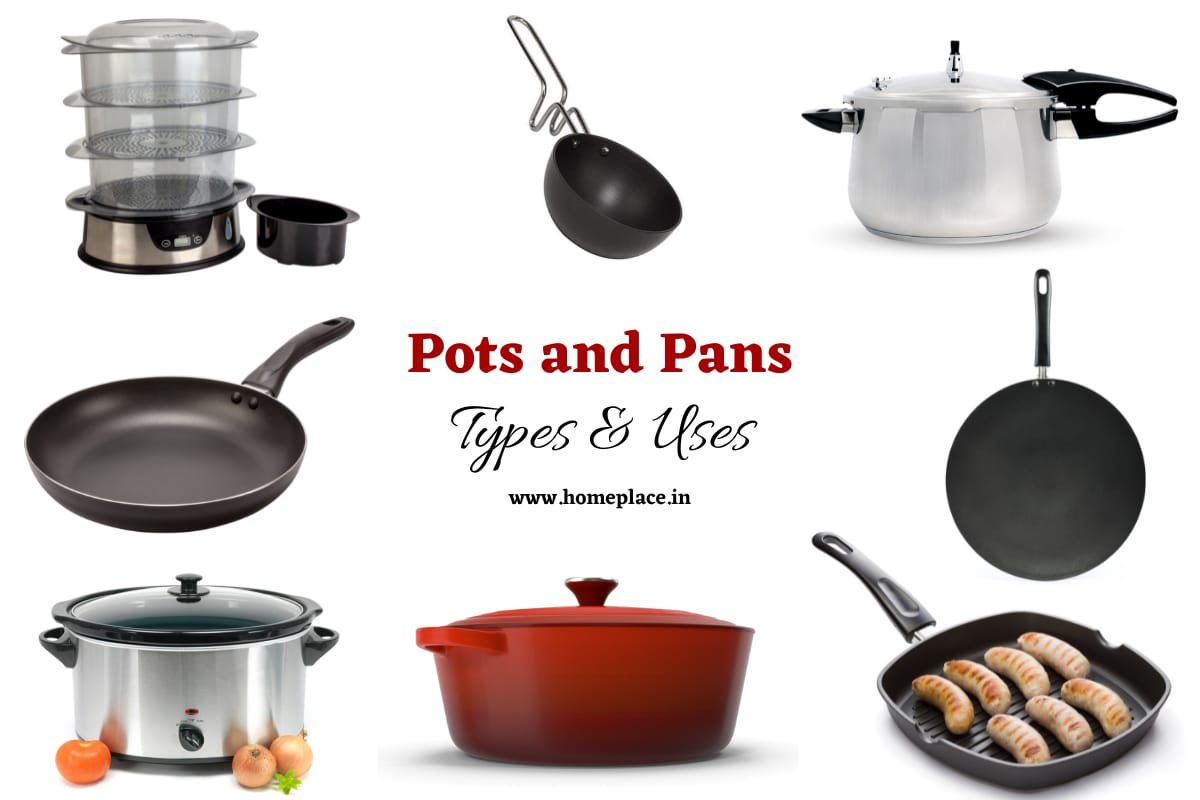
1. Frying Pan and Skillet
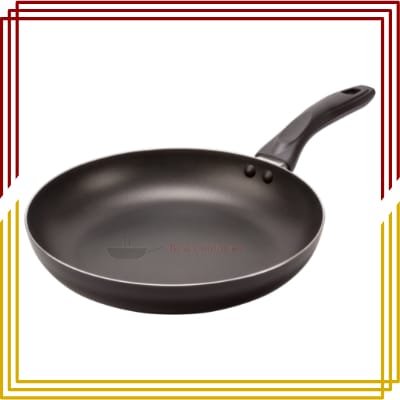
A frying pan is a type of cooking pan that is affordable for most households. It is a must-have for the kitchen – one of the versatile cookware you’ll ever own.
A frying pan has a flat bottom surface with curved sidewalls for stir-frying, mixing of food without spilling. It is used mainly for searing or cooking various ingredients.
Whether you prefer stainless steel cookware for searing or non-stick pans for your eggs, we have the right match for you.
Different materials like aluminum, stainless steel, copper, cast iron create excellent heat conductors. Coatings like ceramic, enamel , silicone, and teflon make the pan non-stick. These pans are generally used for foods that tend to stick, which requires little or no oil for cooking. It is comparatively easier to clean.
Frying pans are available in different sizes and capacities ranging from 8-12 inches and 500 ml to 2 liters, respectively. Depending upon the size, capacity, and material used, its price varies from Rs. 400 to Rs. 2000. The best frying pan is worth its cost as it helps in frying over moderate to high heat. And most importantly, it can be used to make almost anything available in your kitchen.
Uses of Frying Pan
- Searing meat.
- Scrambling eggs.
- Making omelets, pancakes, uthappam.
- Frying veggies, chicken, etc.
2. Grill Pan
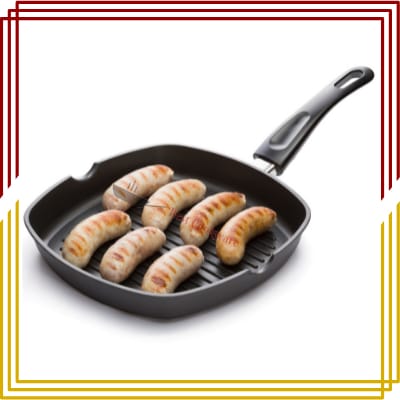
It is a type of frying pan with a sequence of ridges generally used to cook food with radiant heat on a stovetop. A grill pan can be found in square, round, or rectangular shapes. It comes with a heat-resistant, preferably long handle for protection.
Materials like cast iron, cast aluminum, stainless steel, and enameled steel make grill pans. However, cast iron is known as an ideal material for a grill pan due to its high durability and capacity to retain heat at high temperatures. It comes with both non-stick and traditional surfaces.
A grill pan allows the food to be simmered, preserving the juices in meat, fish, and vegetables. It can also be employed in steam cooking by allowing moisture to build up in the spaces between the ridges in the pan.
A grill pan is comparatively more challenging to clean than the frying pans, as the oil scorches onto the pan in the grooves between the ridges. For a household, 8-12 inches grill pan with a capacity of 1.05-1.7 liters is ideal. These pans lie in the same range as frying pans, starting from Rs. 450 to Rs. 2000 and are affordable to a middle-class household.
The best grill pans are worthy for our kitchen as they are decent at giving you beautiful sear marks and a good charring. It imparts an aesthetic grilled flavor and texture to your food.
Uses of Grill pan
- Making grilled meat, fish, and vegetables.
- Making bacon, sandwiched covered with grill marks.
- Low-fat meal hence, a healthier choice.
3. Sauté Pan
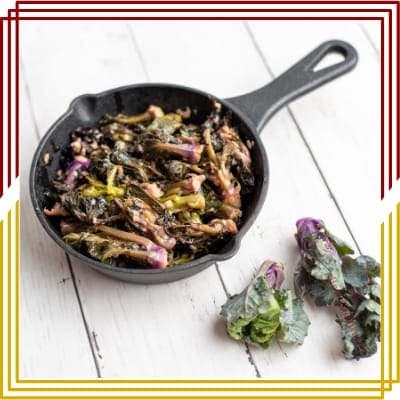
A sauté pan is one of the different types of cooking pots and pans in India. These are analogous to fry pans in design; they too have a flat surface. However, the main contrast is that instead of having curved sides, sauté pans have straight sides, which provide a larger surface area.
Sauté pans are predominantly available with a long handle and a lid. Several materials like copper, aluminum, cast iron, stainless steel, non-stick coating and a combination of many materials are used to build a sauté pan.
However, anodized aluminum is preferably used as it transmits heat effectively, is cheaper than most materials, and is easy to clean.
The typical size of a sauté pan is between 14 cm and 30 cm, with capacity varying from 1 liter to 4 liters sequentially. This pan is a little costlier than frying pans ranging from Rs. 500 to Rs. 3500. It is not economical for a general household. It is recommended to go for a frying pan rather than a sauté pan due to its sloping sides, making the pan more versatile.
The primary purpose of a sauté pan is sautéing, which means frying foods. It is worth it for our kitchen as it cooks food quickly over high heat in a little bit of oil. While making a sauce, the straight sides help by keeping the liquid from spilling over the sides.
Uses of Sauté Pan
- Searing meat.
- Sautéing.
- Preparing sauces like marinara.
4. Sauce Pan and Pot
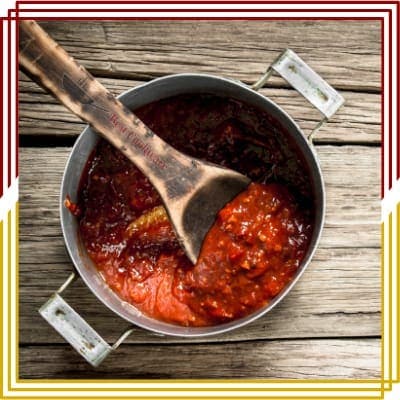
Saucepan and Pot are two different cookware with some similar functions. A saucepan has a round surface with high straight sides and a long handle. It usually comes with a lid.
On the other hand, sauce pots have high walls, a large diameter base, with looped handles on each side.
Both the saucepan and saucepot are designed for quick evaporation and reduction of sauces.
Cast iron, copper, stainless steel, aluminum are some materials used in their making. Aluminum is typically used due to its lightweight, affordable nature, and efficiency in heat conduction.
Sauce pots are generally larger than pans and are costlier too. Sauce Pans are available with a size of 18 cm (2 L) to 20 cm (3 L), valuing Rs. 1000 to Rs. 1500 respectively. While Sauce Pots are available in 20 cm (3 L) to 24 cm (5 L), costing Rs. 2000 to Rs. 2500 respectively.
If you are considering investing your money, it is recommended to go for a saucepan as it can be used as a pot; however, the reverse is not possible. Saucepans are valuable for their versatility. It is a go-to pan in our kitchen. Nevertheless, pots are worth it for boiling and slow cooking.
Uses of Sauce pots and pans
- Pots are used for boiling pasta, soups; preparing stew, chili, stocks, etc.
- Pans are also used for boiling, preparing rice, reducing gravies.
- Pans are used to make hot beverages like tea, hot chocolate; reheating leftovers.
5. Kadai and wok
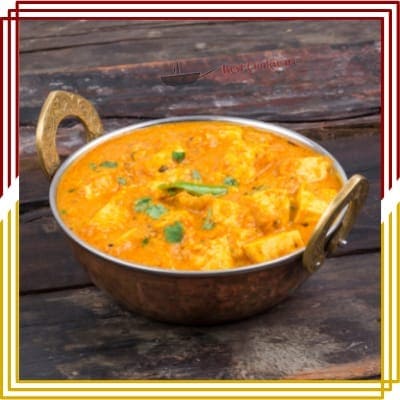
Wok and kadai may appear the same but are two different utensils performing different functions. Kadai is a deep fry pan with a flat bottom surface and two handles attached to each side.
On the other side, the wok is a shallow bowl with a round surface and has two handles screwed on each side. A wok is ideal for cooking Chinese foods. Kadai is perfect for Indian cuisine.
Carbon steel is the best-suited material for a wok. At the same time, a Kadai is made of materials like aluminum, stainless steel, and cast iron.
A wok is available in sizes ranging from 10 inches(3 L) to 20 inches (7 L). You can find kadai with a diameter of 7.5 inches (1.8 L) to 11 inches (3.6 L) and even longer. The average cost of a wok is from Rs. 1000 to Rs. 5000 while that of a Kadai is Rs. 800 to Rs. 4000. Heavy bottom kadai is preferable as it provides more stability when cooking.
Both Kadai and Wok are affordable and are worth it for their functions. Also read
Uses of kadai & wok
- A wok is used for cooking zucchini, broccoli, and other veggies; deep-frying fritters.
- Kadai is used for preparing chicken, mutton, pan-searing meat.
6. Handi Pot/ Rice Pot/ Gundi
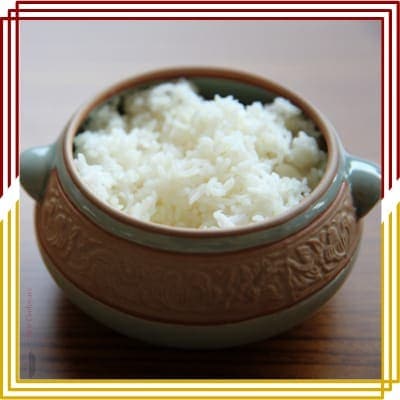
A handi is a must-have cookware and is budget-friendly for most households. It has a deep, broad mouth with rounded edges to retain heat and prevent any cuts and bruises. Sometimes, a lid is provided with it to ensure safe cooking.
Handi is generally used in north-Indian cooking. A typical handi is made of clay or copper. However, materials like aluminum, stainless steel, and a blend of certain ingredients are also used in its making.
As the name suggests, the primary purpose of handi is to cook rice evenly. Nonetheless, it is also used in preparing curries and certain vegetables.
The standard size of a handi or a rice pot for regular kitchen use lies between 7 inches (3 L) and 10.5 inches (4.5 L). The rate of a handi starts from Rs. 540 to Rs. 2000.
It is worth it for our kitchen as it can be used both for cooking and serving; easy to clean; conducts heat evenly, thereby making our food delicious. However, if you like to cook rice automatically, an electric rice cooker can be a good option for you.
Uses of handi
- Clay pots add an earthly flavor to the food; maintain the nutritional value.
- Prepares Handi Khichdi, Handi Biryani, Handi Paneer, Chicken Handi, etc.
- Serving and Cooking.
7. Braiser Pan
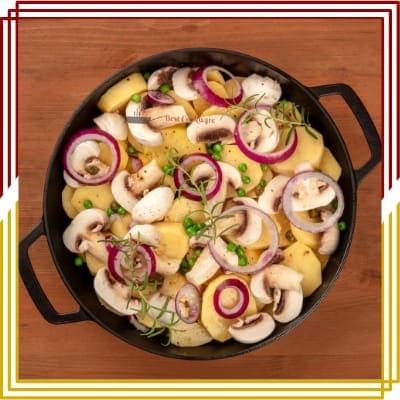
A braiser pan or tilting skillet consists of a griddle on the bottom with sides straightly raised, which allows water on the side of the pan to slide back onto the food to keep it moist. It comes with a tight-fitting lid with short handles on the sides.
Materials like stainless steel, aluminum, anodized aluminum, and cast iron are used to make braiser pans. Typically, cast iron cookware is preferred due to its heat retention and thermal capabilities.
The primary purpose of a braiser pan is to quickly brown food, simmer food products, and sear meat evenly without turning the meat over.
A braiser pan is available in 10 inches to 12 inches in diameter, with a capacity ranging from 40 liters to 110 liters. It costs around Rs 2000 to Rs 10000, which is high-priced for a middle-class household. But, it is worth it for our kitchen as it reduces preparation time, increases batch consistency, and saves energy.
Uses of braiser pans
- Frying donuts, fried chicken, fish fillets, and fries.
- Serving as a kettle for cooking soups, stew, chili, and many other items.
- Browning and searing of meat.
8. Roasting pan
A roasting pan is an oven-safe, high-walled pan specially designed for roasting foods.
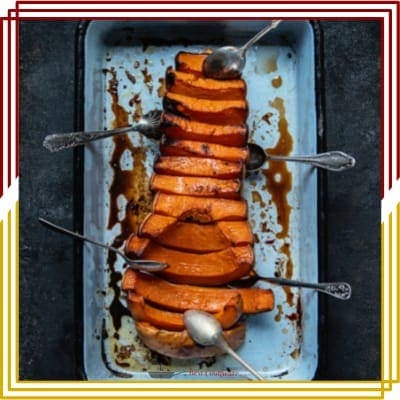
The high wall traps heat inside, which allows for storing, collecting liquid and makes tenting easy as pie. It is often paired with roasting racks, enabling the meat to sit above fat and juice drippings.
Stainless steel, aluminum, cast iron, carbon steel are used in its making. However, heavy-duty material like cast iron with a non-stick surface is mainly used to retain and conduct heat evenly throughout the surface.
It is mainly intended to cook meat, veggies, and starches in the oven at a high temperature, usually around 350 degrees of Celsius and hotter.
A roasting pan is available in sizes varying from 14 inches to 20 inches which can cost somewhat around Rs. 800 to Rs. 3000. If you roast meat frequently, then owning a roasting pan is worth it.
Uses of roasting pan
- To roast large chunks of meat evenly.
- Braising meatballs, deep-dish pizza, etc.
- Spaghetti squash, broccoli, lasagna, and many more.
9. Dutch Oven
A Dutch oven is large, heavy, thick-walled, usually cylindrical in shape. It has been used as a cooking vessel for hundreds of years. The Dutch oven has a tight-fitting lid and two sturdy, outward-facing handles.
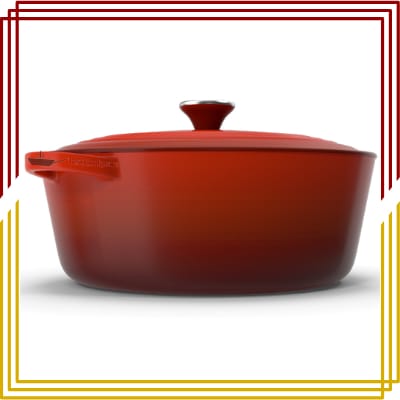
The ability of a Dutch Oven to serve any stovetop or oven cooking dish makes it worthy for a cookhouse. It is one of the unique types of cookware used for both cooking and serving.
Materials like cast iron, cast aluminum, ceramic, terracotta are used in its making. Ideally, cast iron is used due to its temperature regulation and excellent heat retention property. It also distributes heat evenly. It is best suited for prolonged, slow-cooking in making roasts, stews, etc. by locking the flavor, and making the food delicious.
For a household, an 8 to 12 inches Dutch oven is considered perfect. It has a capacity of 1.9 liters to 5.5 liters, respectively. The price of a Dutch oven starts from Rs. 700 to Rs. 4000, which is within budget for a standard kitchen.
Uses of Dutch Oven
- It is used in stewing, braising, simmering, searing, boiling, etc.
- In an oven, it is used in roasting and baking.
- To make tender and gentle meat like a chicken braise.
- Browning meat, preparing soups, making pasta, and many more.
10. Casserole
It is a large, deep pan or bowl used for cooking dishes in the oven and on the hob (depending upon its material) and a serving dish.
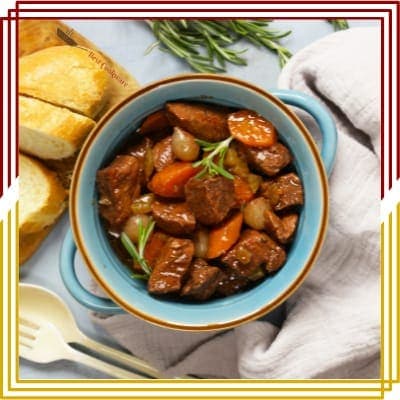
Oval-shaped casseroles are better than round ones as they are conducive to cooking.
It is budget-friendly cookware with a charming glossy exterior is charming. A casserole is worthy for our kitchen as it serves both cooking and serving a purpose.
Materials like glass, ceramic, and metals like aluminum, stainless steel, cast iron, and non-stick make a casserole.
Glass and ceramic cookware are used as they are more attractive and distribute heat evenly. But they can only be used in ovens. To use a casserole on a stove, metals are used in its making. A metal casserole not only can withstand sudden fluctuation in temperature but also creates a brown crust that is super yummy.
The main purpose of a casserole is in baking, storing, and serving. The best casseroles are available in sizes ranging from 9 to 15 inches, having a capacity of 2.5 to 5 liters. The average cost of a casserole is Rs. 800 to Rs. 3000.
Uses of casserole
- Searing onions and other veggies.
- It gives a roasted, golden crisp.
- Make soups, stews, pot roasts, etc.
11. Slow Cooker
The slow cooker is a table-top electrical cooking appliance with a base with a heating element, a pot, and a glass lid. It comes in round or oval shapes.
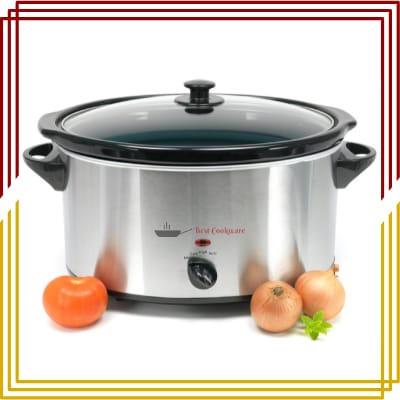
Its purpose is to perform slow cooking, thereby facilitating hands-off cooking. Most slow cookers are provided with low, high, and warm settings, i.e., the temperature ranging from 175°F to 215°F.
A slow cooker is cheap to buy, economical to use, and is budget-friendly cookware. It is worth it for our kitchens as it promotes healthy cooking, brings out the recipe’s authentic flavor, and is convenient to use and clean.
Also referred to as a crock-pot, it is constructed of heavy stoneware that keeps the heat constant, even, and stable. The pot is made with an electric heating metal covered with either of ceramic or porcelain. The lid is usually made of glass. Sometimes, toxins like lead, cadmium, mercury are hidden in the ceramic glaze, which is very harmful to one’s health. Thus, always prefer a reputed brand that ensures food-safe materials.
Slow cookers are obtainable at various sizes from 1-2 qt. (1.7 L) to 10 qt. (11.3 L). Generally, a 5-6 qt. size cooker is used. The standard size of a slow cooker costs around Rs. 2200 to Rs. 3500.
Uses of slow cooker
- Produces tender meat.
- Best for seafood, fish, and lean meats like chicken breasts.
- Prepares stew and soup.
12. Pressure Cooker
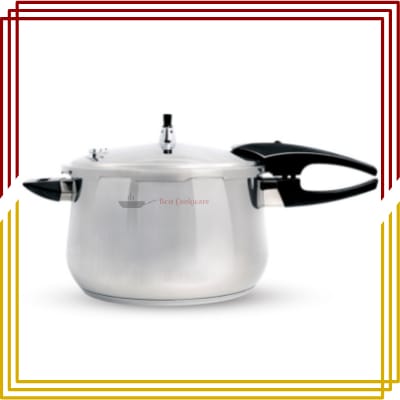
A pressure cooker is a type of cookware used in Indian households daily. It is a sealed pot that cooks food under high pressurized steam evolved from water or a liquid.
It comprises a pan, lid with a locking device that can be tightly fit over the pan. A gasket (sealing ring) seals the cooker and a handle is also provided. It is pocket-friendly cookware and is a must-have for kitchens.
A pressure cooker reduces cooking time by up to 50% by decreasing the boiling point of the liquid. It also retains all the nutrients, making the meal healthy. Its main purpose is to cook food with steam which saves enormous energy and retains the food flavor. To sum up, it is worth it to buy a pressure cooker.
Aluminum, stainless steel, and anodized aluminum are the materials used in building a pressure cooker. However, a stainless steel pressure cooker is preferred over other metals because of multiple reasons. It is lightweight, durable, colorful, and does not affect health.
Pressure Cookers are available in a wide range, starting from 2 liters to 10 liters. Many cookers are also available with a capacity of more than 10 liters. Nevertheless, the standard size is 3 L -6 L. The price range of a pressure cooker is around Rs. 800 to Rs. 2800.
Apart from stainless, aluminum and hard anodized pressure cookers, you can also check out electric pressure cookers that make the whole cooking process automatic.
Uses of pressure cooker
- Ideal for making soups, pulses, and risottos.
- Poaching and braising can also be done.
- Almost any liquid-based food can be prepared.
13. Tadka Pan
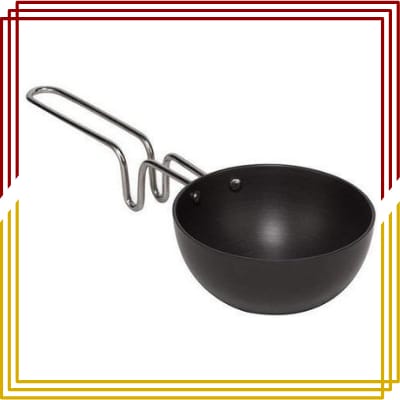
A tadka pan is also known as Seasoning Pan or Melting Pot. It has a shape of a ladle and is attached with a long, sturdy handle for a smooth grip. A tadka pan is an essential type of cookware chiefly for Indian households.
Cast iron, stainless steel, aluminum, hard-anodized aluminum are some metals used to make a tadka pan. Hard anodized cookware is superior over other types of pots and pans in India. The reasons are its highly durable and corrosion-resistant nature. It also has excellent heat conduction property and is non-reactive.
The standard size of a tadka pan stretches from 9.4 cm to 15 cm, with a capacity of 150 ml to 500 ml, respectively. Its price varies from Rs. 200 to Rs. 600, which is pretty affordable for a general household.
This tiny pan has a relatively deep base that helps move the tadka quickly and prevents the spices from jumping out of the pan. Tadka pan is worth it for our kitchens as it adds spices to our food and brings out a savory taste that is finger-licking good.
Uses of tadka pan
- Tempering dal, rasam, sambhar, dhokla, chutney, and many other dishes.
- Melt butter, cheese.
- Roast coffee beans.
14. Biryani Pot
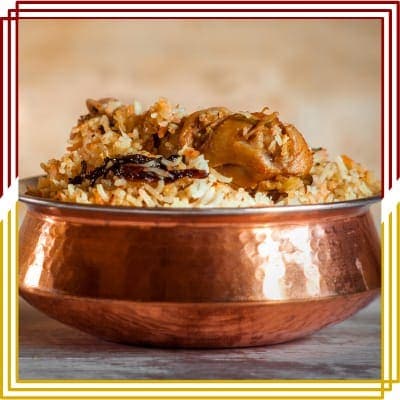
Biryani is an emotion for all the foodies out there. To cook it authentically, you need a biryani pot. Originated from the Indian sub-continent, a biryani pot is one of the unique type of cooking pot in the kitchen, widely used in north India, Pakistan, and Bangladesh. The best biryani pot has a deep and wide mouth with a heavy bottom and a lid.
Materials like aluminum, clay, copper, steel, and iron are used to build a biryani pot. Traditionally clay pots were used to make biryani.
Nowadays, aluminum or hard anodized biryani pots with non-stick coating are preferred due to its heat retention and conduction property. It is highly durable. A biryani pot is durable, conducts heat evenly, maintains residue-free cooking. And importantly, these pots are available in beautiful designs and styles.
Biryani pots are obtainable in a variety of sizes. From 2 liters to 15 liters, these are available in all sizes costing around Rs. 1000 to Rs. 4000. It is a little costlier for a pot that serves only limited purposes. If you are a biryani fanatic and eat it frequently, this pot is a boon to your kitchen.
Uses of biryani pot
- Making mouth-watering Biryani.
- Steaming rice and searing meat.
15. Idli Maker/Steamer
Famous in south-India, an idli maker is one of the finest type of cookware used in our Indian households. The main purpose of an Idli maker is to make soft, fluffy Idlis simultaneously and instantly.
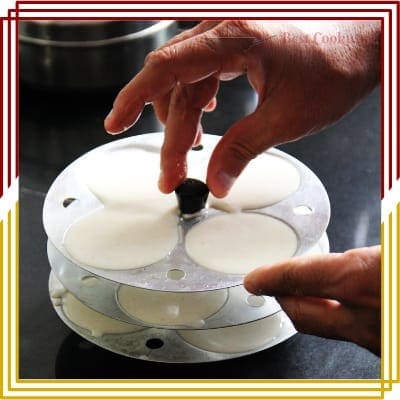
It comes with round-shaped (idli-shaped) plates having small holes for the steam to escape. The knobs and handles are resistant to heat. Some are provided with a whistle to release steam.
Aluminum, stainless steel, anodized aluminum, ceramic are some materials used in its manufacturing. However, stainless steel is given priority, among others. Stainless steel is resistant to rust and corrosion, easy to clean, durable, and sturdy.
The best idli makers are available from 2 L (which can make 8 Idlis) to 8 L (which can produce 32 Idlis), costing around Rs. 350 to Rs. 1900. Idli maker is inexpensive to buy, economical to use, and is an essential buy for Idli lovers. It is worth having in our kitchens as it is a piece of multi-purpose equipment, easy to maintain, and makes healthy idlis.
Uses of idli maker/ steamer
- To make delicious and soft Idlis.
- Used to make dhokla, cooker cakes, Patra, momos, etc.
- Used to steam veggies.
- It can also be used to make curries and in deep-frying without the Idli stand.
16. Tawa
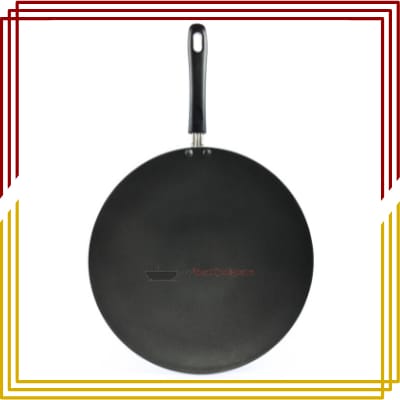
Widely known as tawa, tapa, tawah, saj, tavah, is a common type of pan present in every Indian household. It is either a flat or concave disc-shaped pan or griddle, with or without a handle, and is used for cooking several things. A tawa is a versatile cookware used for making numerous dishes.
The main purpose of a tawa is to make a variety of leavened and unleavened flatbreads and pancakes without any hassle. A tawa is well-known cookware in South Asia including India.
Materials like cast iron, aluminum, sheet iron, carbon steel, steel, non-stick coating like Teflon make tawa. Cast iron is the best-suited material due to its heat-retaining nature and thermal capability. It also conducts heat evenly.
The standard size of a tawa is 20 cm to 35 cm. The price of the best tawa varies from Rs. 1000 to Rs. 3000. Thus, it is budget-friendly pan to make dosa, roti and chapati.
Uses of tawa
- Makes a variety of flatbreads— chapati, roti, cheela, naan, pita, etc.
- Also used to make dosa, pancakes.
- Large tawa is used for making aloo chat, tawa masala, pav bhaaji.
- Frying fish and meat.
17. Fajita Pan
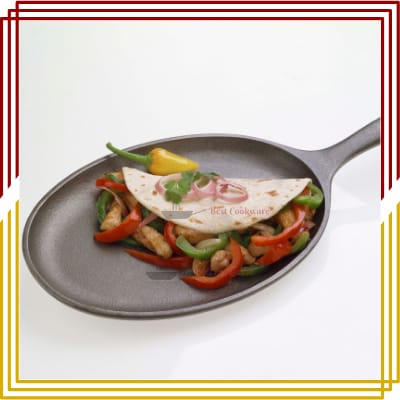
Originated in the United States and Mexico, fajitas are now famous worldwide. Fajita pans are short-walled and have a circular cooking surface and a wooden base, present with or without a handle.
Its main purpose is to make flavorsome fajitas and quesadillas. The round surface helps in accommodating steak, vegetables, chicken, and shrimp.
Cast iron, aluminum, anodized aluminum are a few materials used in its making. Due to its temperature regulation and thermal capability, cast iron is given priority over other materials. It retains heat and conducts heat evenly throughout the cooking surface. The handles are also made of cast iron, so it is suggested to use oven mitts to hold it.
Though a fajita pan can be used both on the stovetop and in the oven, it is slightly pricey. Fajita pans are available in sizes from 7inches to 17 inches. The starting price of a fajita pan is Rs. 1500. It goes higher up to Rs. 3600 and much more. Fajita pans are worth it as it a culinary spectacle. It is good cookware for outdoor barbecue and buffet.
Uses of Fajita pan
- To make fajitas and quesadilla.
- To prepare searing hot ingredients such as meat, seafood, fish, and vegetables.
18. Milk pots and topes
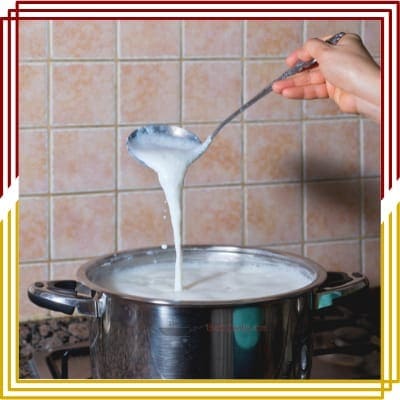
The milk pots and topes are some of the essential types of pots found in the kitchen. As the name suggests, the purpose of a milk pot and tope is to boil and pour milk. It has a round bottom surface with high straight or curved sides raised. Sometimes, a lid is provided with it. Some pots have an induction base.
The base thickness should be greater than 3 mm, as it helps in uniform heating. The high sides prevent spillage.
A lip is usually incorporated into the rim of the pan, which makes pouring more accurate. The milk pot preserves the valuable nutrient and flavor of milk. In addition, to boiling milk, it is also used for several other purposes. Therefore, it is worth it for an available kitchen.
Materials like aluminum, stainless steel, ceramic are used to make a milk pot. Mainly, milk pots and topes are made of stainless steel. It has superior heat conductivity, is highly durable, resistant to rust and corrosion, and is easy to clean and use.
It is available from 12 cm to 28 cm in diameter, carrying a capacity of 420 ml to 4000 ml sequentially. Milk pots and topes are affordable as it costs around Rs. 100 to Rs. 2000.
Uses of milk pots and topes
- Boiling milk and soups.
- Preparing coffee, tea, and other liquid products.
- Making curries and other vegetable dishes.
19. Omelet Pan
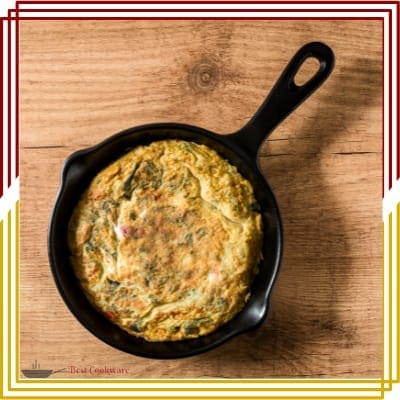
A omelet pan is a type of cooking pan that can be oval or round, with a thick flat bottom, sloppy sides, with or without a lid. A long handle is attached to it for proper balancing and good grip. The sloppy sides make the omelet brown fresh, prevent sticking to the pan.
The thick flat bottom allows cooking from low to high heat, ensures the omelet doesn’t burn and prevents pan warping.
The primary purpose of an omelet pan is to keep the omelet from sticking to the cooking pan. It should also help in flipping the egg and prevents the omelet from breaking. If you have an omelet in your breakfast regularly, then this pan is a must-have for you. It makes cooking an omelet easier and delicious.
Copper, stainless steel, carbon steel, aluminum, anodized and non-stick coating are a few materials used in its building. However, stainless steel is given preference. As it is rust-resistant, extremely durable, excellent at heat distribution, and is easy to clean. A non-stick cookware helps in releasing the omelet with little oil or butter.
The best omelet pan is affordable for most people. It is widely available from 8 inches to 12 inches in size and costs Rs. 580 to Rs. 1000, respectively.
Uses of omelet plate
- Making a yummy omelet.
- To make grilled cheese, bacon.
- Frying steak.
- Sautéing vegetables.
20. Double boiler pot
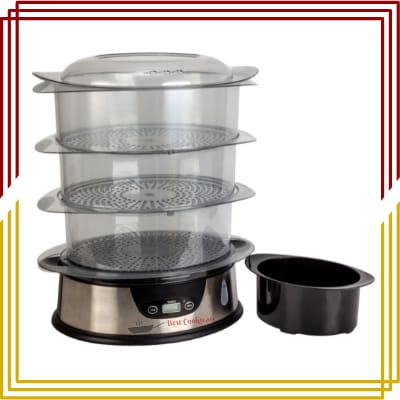
It is a standard type of pot for our kitchens that comprises two pieces: larger and smaller containers.
The larger vessel is filled with hot boiling water. The smaller pot is nestled inside, and the larger one utilizes the steam from the hot water to cook food.
It has a see-through glass lid which helps to monitor cooking.
The primary purpose of a double boiler pot is to cook food with an indirect source(steam) and to provide precise temperature control. It is worthy for cooking as it distributes even radiant heat using the water’s heat to heat the smaller pot’s conductive surface.
Many materials like aluminum, anodized, stainless steel are used in its manufacturing. The larger pot is made of stainless steel generally, as it distributes heat evenly, is exceptionally durable, and is easy to clean. The smaller pot is made of glass, Pyrex, ceramic, or metal. However, glass is preferred.
A double boiler is available in sizes varying from 16 cm (larger pot) and 14 cm (smaller pot) to 26 cm (larger pot) and 24 cm (smaller pot). The price varies from Rs. 800 to Rs. 3000.
Uses of double boiler pot
- Commonly used in bakeries or cafes for melting and baking delicate foods.
- Preparing a special hollandaise sauce.
- Melting chocolate and butter.
- Creating custard.
The above information about the different pots and pans in India will guide you to choose the best cookware for your kitchen. A simple tip from our end— if you want to select the best cookware set, always go for heavier pans and pots as they are made from better quality materials and are safer to use. With better knowledge of the right cookware, you can make your meals simple, healthy, and delicious.
Related Posts:
